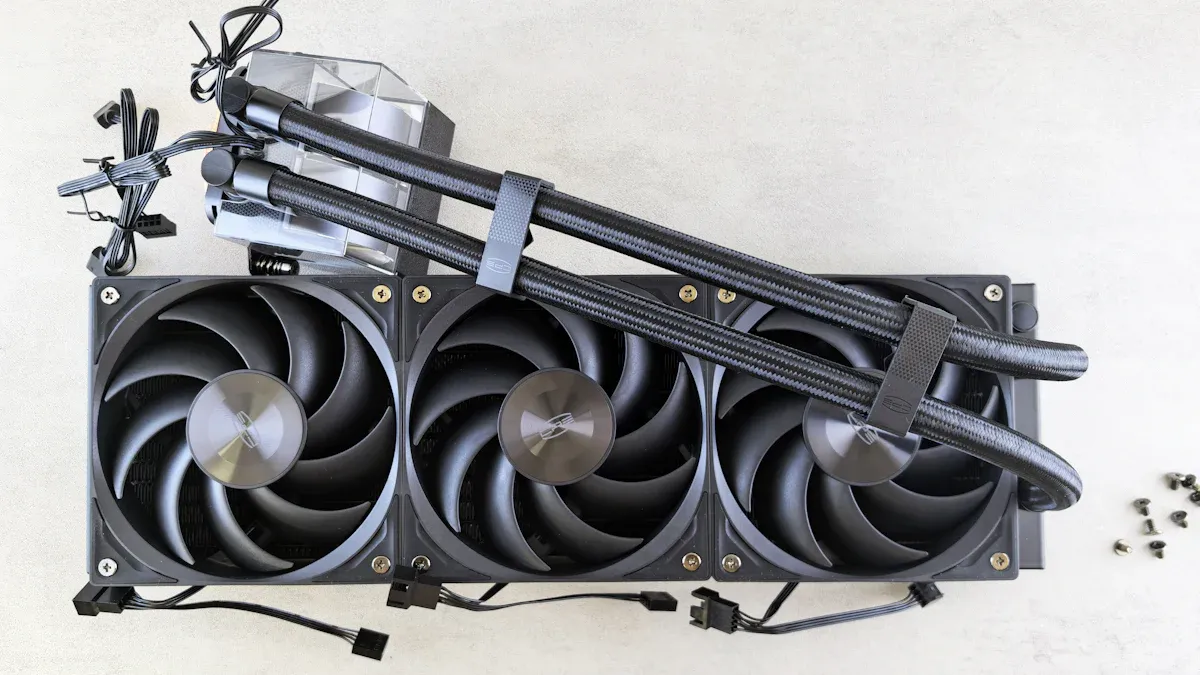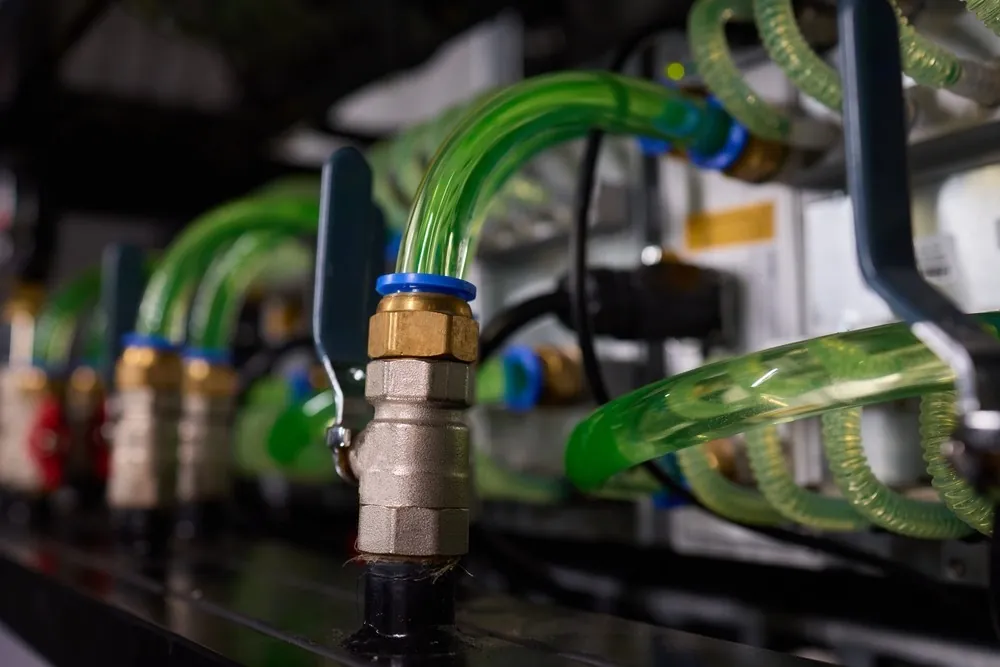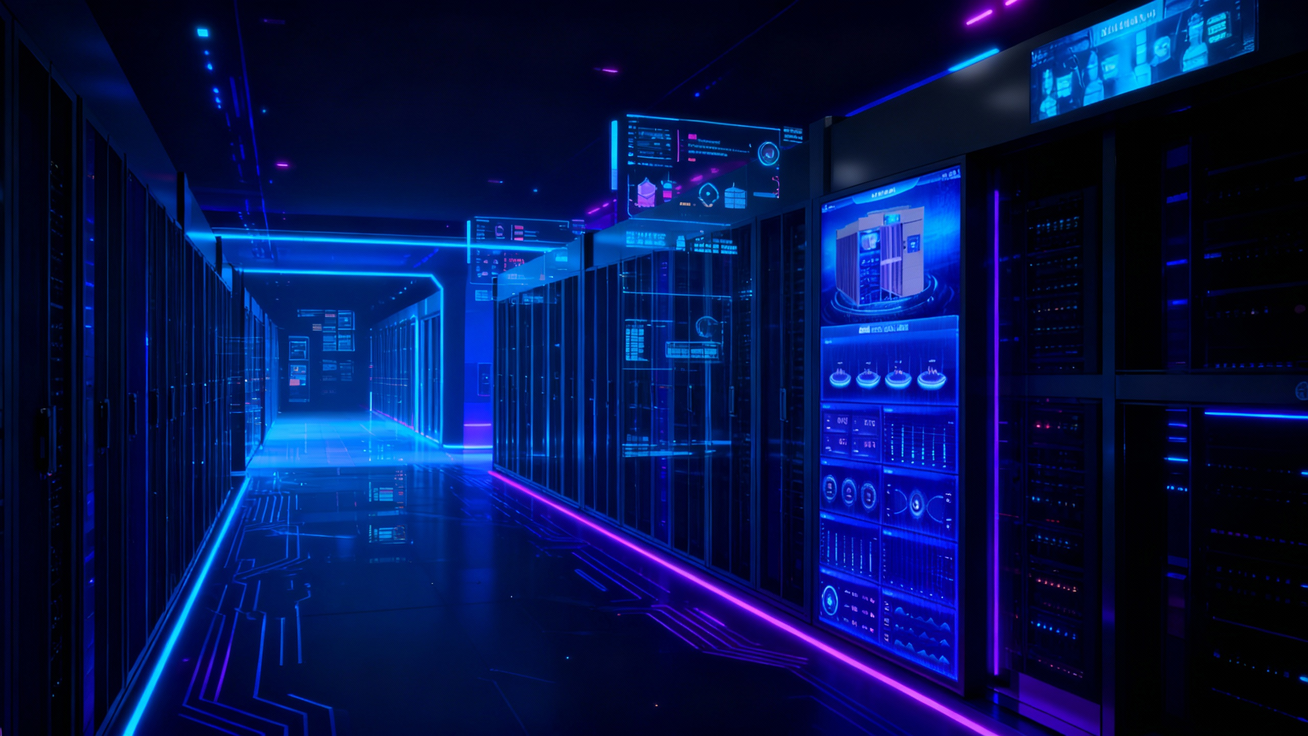You use digital services every day, but most people do not know how much energy is used for each click. Data centers all over the world give off about 250 million metric tons of CO2 each year, says Morgan Stanley. Data center Liquid Cooling is a big change. It helps handle lots of computing and uses less energy. Experts think this technology will grow quickly. The market could be worth more than $21 billion by 2032. This change helps you support a greener and better digital future.
Table of Contents
ToggleKey Takeaways
Data center liquid cooling uses special liquids to cool computers. It cools them faster and uses less energy than air cooling.
This technology saves a lot of energy and water. It helps lower carbon emissions and keeps the environment safe.
Liquid cooling helps high-performance computing like AI. It handles more heat in small spaces. This makes data centers work better and be more reliable.
Liquid cooling can cost more at first. But it saves money later by using less energy and needing less maintenance. It also grows better as needs change.
Hybrid cooling systems make it easy to switch from air to liquid cooling. This helps data centers grow and meet new green tech rules.
Green Tech Urgency

Environmental Impact
You might not know how much data center cooling hurts the environment. Most data centers use air or water to cool their equipment. These ways use a lot of energy and water. The table below lists the main problems:
Environmental Impact | Description | Relation to Traditional Cooling Methods |
|---|---|---|
High Energy Consumption | Old air cooling systems use lots of energy and make more carbon. | Air cooling needs a lot of power to move and cool air. |
Significant Water Usage | Water cooling uses millions of gallons each year, which can cause water shortages. | Water cooling always needs water and chemicals to work. |
Chemical Use | Water cooling needs chemicals to stop scale and germs, which can hurt nature. | Chemicals are put in water for cooling towers and coolers. |
Carbon Footprint Increase | Using non-renewable energy for cooling makes more greenhouse gases. | Old cooling uses grid electricity, often from fossil fuels. |
Data centers use about 1% to 1.4% of the world’s electricity. This is as much as some countries use. Cooling systems can use over half of a data center’s energy. Water use is also a big issue. A medium data center can use as much water as many hospitals or golf courses each year. Many operators do not track their water use, so it is hard to get better at saving water.
Need for Change
The digital world is growing fast. Cloud services, AI, and big data need more computer power. This puts more stress on cooling systems. Old air cooling cannot handle powerful racks or AI chips. So, energy and water use keep going up.
Cooling systems need to be better to meet new needs.
Liquid cooling takes heat away from parts, saving energy and water.
Using less water helps local people and nature.
Using less energy means fewer greenhouse gases.
🌱 Sustainable cooling, like liquid cooling, helps you support a greener future. You can help lower the carbon footprint and water use of data centers. This change is good for the planet. It also helps your digital world work well and stay safe.
Data center Liquid Cooling

What It Is
You may wonder how Data center Liquid Cooling works and why it matters. This technology uses special liquids to move heat away from computer parts much better than air. The main idea is simple: liquids can carry more heat than air, so you can cool powerful computers faster and with less energy.
There are two main types of Data center Liquid Cooling. The first is water-based cooling. In this method, water or a water-based fluid flows through pipes and cold plates that touch the hottest parts, like CPUs and GPUs. The second type is immersion cooling. Here, you place whole servers or parts into a bath of special fluid that does not conduct electricity. This fluid pulls heat away from every surface, giving even cooling.
Tip: Immersion cooling can use single-phase or two-phase fluids. Single-phase fluids stay liquid, while two-phase fluids boil and then turn back into liquid, which helps move heat even faster.
You can see the main differences in the table below:
Cooling Type | How It Works | Main Benefit |
|---|---|---|
Water-Based | Fluid flows through cold plates on hot parts | Good for known setups |
Immersion | Servers sit in special non-conductive fluid | Best for high heat loads |
How It Works
Data center Liquid Cooling uses several smart designs to keep computers cool. You will find three main systems:
Direct-to-Chip Cooling: Coolant flows through cold plates that sit right on top of chips. This method pulls heat away at the source. You can use this for high-density racks and AI servers.
Immersion Cooling: You place servers in a tank filled with a special fluid. The fluid touches every part, so it cools evenly. Some systems use single-phase fluids, while others use two-phase fluids that boil and condense to move heat quickly.
Closed-Loop Systems: These systems seal the coolant inside pipes and tanks. No air or water escapes. This setup keeps the cooling focused on the computers and saves energy.
You can use Data center Liquid Cooling to support very powerful computers. AI and high-performance computing need a lot of cooling because they use more power and make more heat. With liquid cooling, you can run racks that use over 40 kilowatts of power. This would be hard or impossible with air cooling.
Note: Closed-loop systems need sealed racks and special equipment. They cost more at first, but they save energy and need less maintenance over time.
You can also find hybrid systems. These mix air and liquid cooling. For example, rear-door heat exchangers use liquid to cool the air as it leaves the server rack. This lets you upgrade old data centers step by step.
Data center Liquid Cooling helps you save space, use less energy, and keep your computers running at top speed. You can handle the heat from AI and other new tech without using more water or power. This makes your data center greener and ready for the future.
Benefits
Energy Efficiency
You want your data center to use less energy. This helps you save money. Data center Liquid Cooling can help with this goal. When you change from air cooling to liquid cooling, you use much less power. A study by the American Society of Mechanical Engineers showed big savings. Using liquid cooling for most equipment can cut facility power by 27%. It can also lower total site power by 15.5%. Large data centers using liquid cooling can reach PUE values as low as 1.1. Air-cooled centers often have PUEs around 1.55. A lower PUE means you waste less energy on cooling.
You can look at the table below to see the energy savings:
Cooling Method | Total Power Reduction | Facility Power Reduction | Server Fan Power Reduction | Typical PUE |
|---|---|---|---|---|
100% Air Cooling | Baseline | Baseline | Baseline | ~1.55 |
75% Liquid Cooling | 10.2% | 18.1% | 41-80% | ~1.1-1.2 |
With liquid cooling, your servers need less fan power. This saves even more energy. Your whole system works better and uses less power. These savings help you pay less for energy. They also make your data center better for the planet.
💡 Liquid cooling lets your data center run at higher temperatures. You do not need as much air conditioning, so you save even more power.
Sustainability
You want to help the planet and use less water and energy. Liquid cooling supports these goals in many ways:
You use less electricity, so you make fewer greenhouse gases.
You do not need as much air conditioning, which means less power and less pollution.
Many liquid cooling systems use closed loops. These systems recycle the same coolant, so you do not waste water.
Some systems use special fluids instead of water, which helps save even more fresh water.
You can reuse the heat from your data center for things like heating buildings or greenhouses.
Old cooling systems waste a lot of water each year. Closed-loop liquid cooling systems are different. They keep the coolant inside pipes and tanks, so you do not lose water to evaporation. This is very important if your data center is in a dry area. It also helps if you want to save water during droughts. Microsoft has saved over 125 million liters of water each year in each data center by using closed-loop, chip-level liquid cooling. They also made their Water Usage Effectiveness (WUE) better by 80% in just a few years.
🌎 Liquid cooling helps you lower your carbon footprint and protect water resources. You help the environment and meet your company’s green goals.
Performance
You want your data center to work fast and stay reliable. Liquid cooling gives you better performance than air cooling. Liquids move heat away from your servers much faster than air. This keeps your equipment cool, even when you run powerful AI or high-density workloads.
You can fit more servers into a smaller space. This saves room and lets you grow your data center without building new places.
Your servers run quieter because they do not need as many fans.
You can keep your data center at a higher temperature, which saves even more energy.
Liquid cooling also helps your equipment last longer. It keeps the temperature steady, so your servers do not get damaged by heat. This means fewer breakdowns and less money spent on repairs or replacements. You also make less electronic waste, which is good for the planet.
Many top companies use liquid cooling to boost performance and support new technology. Microsoft, Google, Cisco, and Dell all use liquid cooling for their data centers. They report better energy efficiency, lower water use, and the ability to handle tough AI workloads. Companies like Submer and Green Revolution Cooling offer solutions that help you manage extreme heat and improve efficiency.
🚀 With Data center Liquid Cooling, you get faster, greener, and more reliable data centers. You stay ready for the future of high-performance computing.
Air vs. Liquid Cooling
Efficiency
You want your data center to run efficiently. Liquid cooling gives you a big advantage here. Liquids can move heat 50 to 1,000 times better than air. This means you can cool powerful servers without creating hot spots. Direct liquid cooling pulls heat away right at the source, so your servers stay cooler and work harder. You also get less noise because you do not need as many fans. Liquid cooling lets you use warmer coolant, which helps your chillers work better and saves even more energy. Air cooling struggles in high-density areas and often wastes energy trying to keep up. With liquid cooling, you use less power and lower your carbon footprint.
Cost
You might think liquid cooling costs more at first. Air cooling uses common parts like fans and air conditioners, so it seems cheaper to set up. However, when you look at the numbers, liquid cooling can save you money as your data center grows. At higher rack densities, liquid cooling cuts capital costs by 10-14%. Here is a quick comparison:
Cooling Type | Initial Cost per Watt | Capex at 2x Compaction (20kW/rack) | Capex at 4x Compaction (40kW/rack) | Savings Compared to Air Cooling |
|---|---|---|---|---|
Air Cooling | $7.02/watt | N/A | N/A | Baseline |
Liquid Cooling | $6.98/watt | $6.33/watt (10% savings) | $6.02/watt (14% savings) | 10-14% savings at higher densities |

Over time, liquid cooling saves even more. You use less energy and spend less on repairs. For example, some centers have cut energy use by 40% and maintenance by almost 40%. This means you pay less each year and get a better return on your investment.
Scalability
You want your data center to grow with your needs. Liquid cooling makes this easy. You can pack more servers into the same space because liquid cooling handles more heat. This helps you support new tech like AI and high-performance computing. You can upgrade your cooling system as you add more servers, without needing to rebuild your whole data center. Liquid cooling systems use modular designs, so you can expand step by step. This flexibility lets you scale up quickly and efficiently, keeping your data center ready for the future.
Challenges and Future
Barriers
Switching to liquid cooling in your data center is not easy. There are many problems you might face:
If you update old data centers, you must use both air and liquid cooling. This makes things more complicated.
There are not enough clear rules for liquid cooling equipment. This makes upgrades harder.
Water-based cooling can cause shocks or rust in pipes. This can make things less safe and less reliable.
You need special liquids for cooling. Only a few companies make them, so it can be hard to get what you need.
Liquid cooling systems have more parts. This means more things can break.
You need workers who know how to fix these systems. There are not enough trained people yet.
Updating old data centers costs more and takes longer than building new ones with liquid cooling.
Big data centers can handle these changes better. Small ones may have a harder time.
The technology is still new. Some people feel nervous about using it.
💡 It costs a lot to update old data centers. You need to buy new tanks, fluids, and other parts. But you can save money later by using less energy and water.
Solutions
There are ways to solve these problems. Hybrid cooling systems help you switch from air to liquid cooling slowly. These systems use liquid cooling for the hottest parts and air cooling for the rest. This lets you upgrade without stopping your data center.
Description | Benefit | |
|---|---|---|
Rear Door Heat Exchangers | Chilled water cools air as it leaves the rack. | Makes cooling better without full change |
Manage liquid cooling loops and connect to chillers or towers. | Makes it easier to control cooling | |
Partial Liquid Cooling | Only cools the hottest parts, like CPUs and GPUs. | Saves energy by cooling only hot spots |
Integrated Hybrid Solutions | Mixes direct-to-chip liquid cooling with air cooling for less hot parts. | Balances cost and efficiency |
You can add rear-door heat exchangers and CDUs to racks you already have. These upgrades help you cool better and use less energy. You can also upgrade your data center in steps, so it keeps working while you make changes.
Trends
Liquid cooling will become much more common soon. The market could be worth over $20 billion by 2033. It is growing by more than 20% each year. AI and high-performance computing need better cooling. Liquid cooling can move heat up to 3,000 times better than air. Governments are spending money on this technology. New rules want data centers to use less energy.
North America uses liquid cooling the most, but Asia Pacific is catching up fast.
Hybrid cooling systems are getting more popular. They save money and give you more choices.
New ideas, like immersion cooling and waterless direct-to-chip cooling, help save even more energy and space.
Companies like Submer and ZutaCore make systems that use up to 50% less energy and make servers work better.
🚀 Liquid cooling will help make data centers greener. It will help you reach your green goals and keep up with new technology.
You save money and use energy better as time goes on.
You follow new rules about saving energy and water.
You get your data center ready to grow and try new ideas.
Liquid cooling will keep helping the planet and make computers work better in the future.
FAQ
What is the main benefit of liquid cooling in data centers?
Liquid cooling cools servers faster than air. It uses less energy to do this job. Your data center works better and can handle strong computers.
Is liquid cooling safe for my equipment?
Yes, liquid cooling uses closed systems and safe fluids. These fluids do not hurt electronics. If you use the right tools and follow rules, your servers stay safe from getting too hot.
Can I upgrade my existing data center to liquid cooling?
You can add liquid cooling little by little. Many companies use hybrid systems like rear-door heat exchangers. These let you add liquid cooling without stopping your data center.
Does liquid cooling save water?
Many liquid cooling systems use closed loops. This means you use the same coolant again and again. You use much less water than with old cooling. This helps you save water and care for nature.
How does liquid cooling help with high-density computing?
You can fit more servers in a small area. Liquid cooling takes away heat fast. Your data center can run strong AI and other big jobs without getting too hot.







